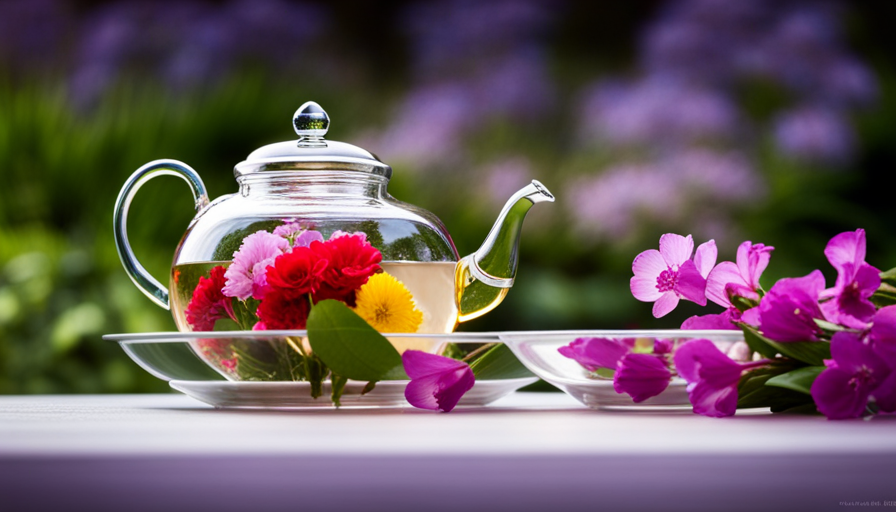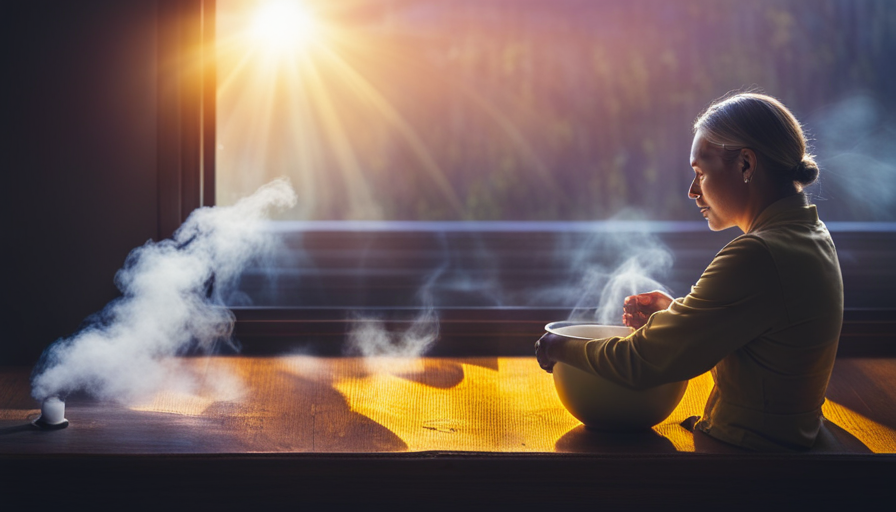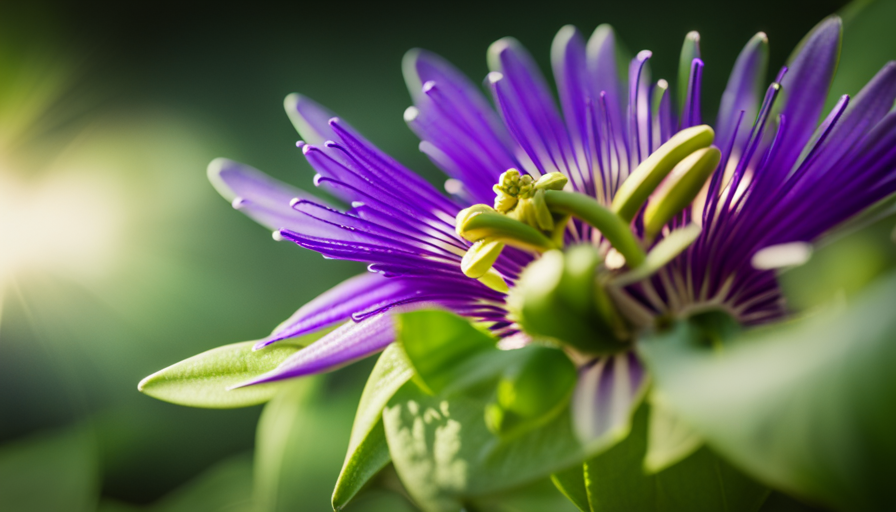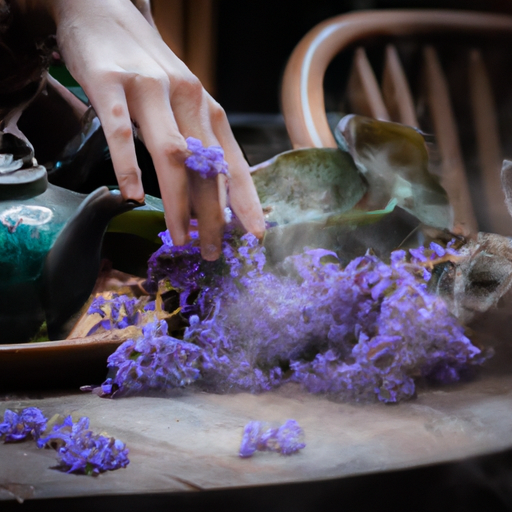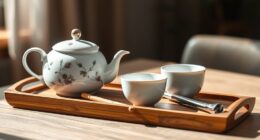Have you ever heard that flower tea has been a popular choice for centuries in different cultures worldwide? It’s not only visually stunning, but also a flavorful and fragrant drink packed with various health benefits.
In fact, a study conducted by the Journal of Nutrition and Food Sciences found that drinking flower tea can help improve digestion, boost the immune system, and reduce stress levels.
If you’re curious about how to brew your own flower tea, you’re in the right place! In this article, I will guide you through the steps of selecting the right flowers, preparing your equipment, and infusing the flowers to create a delicious and soothing cup of tea.
So, let’s get started on this wonderful journey of exploring the world of flower tea and all its wonders.
Key Takeaways
- Choose organic flowers that have not been treated with pesticides or chemicals.
- Different flowers require different steeping times and temperatures.
- Experiment with different flower combinations to create unique flavor profiles.
- Strain the flowers from the tea before enjoying.
Choose the Right Flowers for Tea
Now, you’ll want to choose the right flowers for your tea, so take a moment to envision a vibrant array of blossoms that’ll infuse your brew with beautiful colors and delicate flavors. Flower tea isn’t only visually appealing but also offers numerous benefits for your health.
Certain flowers, such as chamomile and lavender, are known for their calming properties, making them perfect for a relaxing cup of tea before bed. Other flowers, like hibiscus and rose, are rich in antioxidants, which can help boost your immune system and protect against cellular damage.
When selecting flowers for your tea, make sure to choose organic ones that haven’t been treated with pesticides or chemicals.
To brew flower tea, gather fresh flowers from your garden or a trusted source. It’s important to use flowers that’re in full bloom and free from any blemishes or signs of wilting. Once you’ve gathered the flowers, gently rinse them under cool water to remove any dirt or debris. Be careful not to bruise or damage the petals during this process.
With your fresh flowers ready, you’re now one step closer to enjoying a fragrant and flavorful cup of flower tea.
Gather Fresh Flowers
First, step outside and let the vibrant petals of nature’s bouquet dance in your hands. Gathering fresh flowers is an essential step in creating delightful DIY flower tea blends. To ensure the best results, consider these tips:
- Choose flowers that are pesticide-free and edible, such as chamomile, lavender, rose, hibiscus, or jasmine.
- Pick flowers early in the morning when they’re at their freshest and most fragrant.
- Select flowers that are fully bloomed and free from blemishes or signs of wilting.
- Use a pair of sharp scissors or garden shears to cut the flowers, making a clean and angled cut to encourage new growth.
- Harvest only a few flowers from each plant to allow it to continue blooming throughout the season.
By following these guidelines, you can create beautiful and fresh flower arrangements for your tea.
Now, let’s move on to the next step and prepare your tea equipment for the perfect brewing experience.
Prepare Your Tea Equipment
Get ready to elevate your tea experience by preparing all the necessary equipment for brewing your exquisite floral blends. To start, it’s crucial to choose the right teapot for flower tea. Opt for a glass or ceramic teapot, as they allow you to appreciate the beauty of the flowers as they infuse in the water. Avoid using metal teapots, as they may affect the taste and aroma of your tea.
Next, consider the steeping time and temperature for your flower tea. Different flowers require different steeping times and temperatures to bring out their unique flavors. As a general rule, use water that’s around 175°F (80°C) for delicate flowers like chamomile or lavender, and slightly higher, around 195°F (90°C), for stronger flowers like rose or jasmine. Steep your flower tea for about 3-5 minutes, but feel free to adjust the time to suit your taste preferences.
Now that you’ve prepared your teapot and determined the steeping time and temperature, it’s time to measure the right amount of flowers for your brew. Transitioning into the subsequent section, ensuring the perfect balance of flowers will ensure a delightful and aromatic cup of tea.
Measure the Right Amount of Flowers
When it comes to measuring the right amount of flowers for brewing tea, there are a few key points to keep in mind. Firstly, using a tea scoop or spoon can help ensure accurate measurements. Secondly, it’s important to adjust the amount based on personal preference, as some people may like a stronger or milder flavor. Lastly, being precise with the measurements will result in a well-balanced and enjoyable cup of flower tea.
Using a Tea Scoop or Spoon
To effortlessly measure your flower tea, simply grab a tea scoop or spoon. Using a tea infuser is a convenient way to ensure accurate measurements. The amount of flowers needed may vary depending on personal preference and the specific type of flower tea you’re brewing.
Generally, a standard tea scoop can hold about 1 teaspoon of loose flower tea. This measurement is a good starting point for most flower teas. However, it’s important to note that steeping time for flower tea can also affect the strength and flavor. Adjusting the amount of flowers based on personal preference is key to finding the perfect balance.
Experiment with different amounts until you achieve the desired taste and aroma. Transitioning into the subsequent section about adjusting the amount based on personal preference, it’s important to remember that finding the right measurement is crucial for a delightful cup of flower tea.
Adjusting the Amount Based on Personal Preference
Now that we know how to use a tea scoop or spoon to measure the flower tea, let’s talk about adjusting the amount based on personal preference.
When it comes to brewing flower tea, there’s no one-size-fits-all approach. Each person has their own taste preferences, and adjusting the amount of tea can greatly impact the flavor profile. Here are three key considerations when adjusting the amount of flower tea:
-
Adjusting steeping time: Increasing or decreasing the amount of flower tea can affect the steeping time. More tea may require a longer steeping time to fully extract the flavors, while less tea might require a shorter steeping time to avoid overpowering the brew.
-
Experimenting with different flower combinations: Adjusting the amount of flower tea also allows you to experiment with different combinations. Try mixing different types of flowers to create unique flavor profiles and find your perfect blend.
-
Personal taste preferences: Ultimately, adjusting the amount of flower tea is all about finding the right balance for your taste buds. Don’t be afraid to experiment and adjust until you discover your ideal brew.
Now, let’s move on to the next section where we’ll learn how to infuse the flowers.
Infuse the Flowers
Once the flowers have been gathered, you can start infusing them to create a delightful cup of flower tea. To ensure the best flavor and aroma, it’s important to master the proper infusing techniques, as well as control the time and temperature.
To begin, place your desired amount of flowers into a teapot or infuser. The amount will depend on your personal preference and the strength of flavor you desire. Next, pour hot water over the flowers, making sure the water is at the recommended temperature for the specific type of flower tea you’re brewing. For example, delicate flowers like chamomile require lower temperatures, around 175°F, while heartier flowers like lavender can handle hotter temperatures, around 200°F.
Allow the flowers to steep for the recommended amount of time, typically around 3-5 minutes. This’ll give the flowers enough time to release their flavors and aromas into the water. Be careful not to oversteep, as this can result in a bitter taste.
Once the infusing time is complete, strain the flowers from the tea, and your flower tea’s ready to be enjoyed. The next section’ll explore how you can enhance the flavor of your flower tea without adding any additional steps.
Enhance the Flavor
Elevate your cup of floral bliss by adding a touch of natural sweetness or a hint of citrus to awaken your taste buds. When it comes to enhancing the flavor of flower tea, there are several ways to bring out the delicate floral notes.
One option is to add a teaspoon of honey or a sprinkle of stevia to your tea. These natural sweeteners complement the floral flavors and add a subtle sweetness without overpowering the tea itself. Another way to enhance the floral notes is to infuse your tea with a slice of lemon or orange. The citrusy tang brings a refreshing twist to the tea and helps to accentuate the floral aromas.
When it comes to pairing flower tea with food, there are a few tips to keep in mind. Light and delicate floral teas, such as chamomile or lavender, pair well with light and refreshing dishes like salads or seafood. The floral flavors complement the freshness of the ingredients and create a harmonious balance. On the other hand, stronger floral teas like rose or hibiscus can stand up to bolder flavors. Consider pairing them with spicy or savory dishes to create a unique and unexpected combination of flavors.
Now that you’ve enhanced the flavor of your flower tea, it’s time to move on to the next step: straining and serving.
Strain and Serve
To fully enjoy your floral infusion, strain the tea and serve it in your favorite cup, allowing the flavors and aromas to envelop you in a moment of tranquility. Straining the tea is an essential step to remove any loose petals or herbs, ensuring a smooth and enjoyable drinking experience. As you pour the tea through a strainer, watch as the vibrant colors of the flowers blend together, creating a visually pleasing spectacle.
When it comes to brewing flower tea, adjusting the brewing time is crucial to achieving the perfect balance of flavors. Different flowers require different steeping times to release their unique tastes and aromas. For delicate flowers like chamomile or lavender, a shorter brewing time of around three to five minutes is recommended. Bolder flowers such as hibiscus or rose can be steeped for five to seven minutes to extract their full flavor potential.
To add more complexity to your floral infusion, don’t be afraid to experiment with different flower combinations. Mixing flowers like jasmine and rose creates a fragrant and soothing blend, while chamomile and lavender offer a calming and relaxing brew. Get creative and discover your own unique floral combinations that suit your taste preferences.
Now that your tea is strained and ready to be enjoyed, take a moment to appreciate the aroma and taste. Close your eyes and inhale deeply, allowing the floral scents to transport you to a blooming garden. Savor each sip, noticing the subtle nuances of flavors that the flowers impart.
In the next section, we’ll explore how to fully appreciate the aroma and taste of your flower tea without skipping any steps.
Enjoy the Aroma and Taste
When it comes to enjoying flower tea, one can’t ignore the allure of its fragrance. The aroma of flower tea not only adds to the overall experience of sipping the tea but also is pleasant. Each flower has its own unique fragrance. It can range from delicate and floral to bold and aromatic. Moreover, exploring the different flavors of flower tea can be a delightful journey for the taste buds. Each flower offers a distinct flavor profile that can be savored and appreciated. From the subtle sweetness of rose petals to the refreshing citrus notes of chamomile.
Savoring the Fragrance of Flower Tea
As I take a sip of my freshly brewed flower tea, the delightful aroma instantly transports me to a serene garden. Savoring the fragrance of flower tea is not only a sensory pleasure but also a way to explore the benefits it offers.
Each type of flower tea has its own unique fragrance, which can range from floral and sweet to earthy and herbal. The aroma is not only pleasing to the senses but can also have therapeutic effects, promoting relaxation and reducing stress.
Noting the unique flavor profiles of different flowers allows for a deeper appreciation of flower tea. In the next section, we’ll delve into the fascinating world of exploring the taste and characteristics of flower tea.
Noting the Unique Flavor Profiles of Different Flowers
Explore the myriad of flavors that various flowers possess, and you’ll be amazed to discover that over 900 species of flowers are used worldwide to create unique and aromatic teas. When exploring floral tea pairings, it’s important to note that each flower imparts its own distinct flavor profile.
For example, chamomile offers a delicate and soothing taste, while hibiscus provides a tangy and slightly tart sensation. Jasmine, on the other hand, delivers a floral and refreshing note.
Uncovering the origins of flower tea flavors adds another layer of appreciation to the experience. For instance, lavender, commonly used in teas, originates from the Mediterranean region and adds a sweet and herbal undertone.
As we delve further into exploring flower tea blends, we’ll discover exciting combinations that will elevate your tea-drinking experience.
Explore Flower Tea Blends
To fully immerse yourself in the world of flower tea blends, you’ll be delighted by the variety of flavors and aromas that await your taste buds. Exploring unique blends is an exciting journey, as each combination offers a distinct experience.
From delicate rose and chamomile to vibrant hibiscus and lavender, there is a blend to suit every palate.
These flower tea blends not only provide a delightful sensory experience but also offer numerous health benefits. For instance, chamomile can promote relaxation and improve sleep quality, while hibiscus is known for its potential to lower blood pressure. Lavender, on the other hand, can help reduce anxiety and promote a sense of calm.
By incorporating flower teas into your daily routine, you can enjoy their therapeutic properties while indulging in a delicious beverage.
As you explore the world of flower tea blends, you’ll discover the health benefits they have to offer. From boosting your immune system to improving digestion, these blends can be a natural remedy for various ailments.
So, get ready to embark on a flavorful journey and uncover the many ways flower teas can enhance your well-being.
Discover the Health Benefits
Indulging in a cup of flower tea blend is like sipping on a soothing elixir that can work wonders for your overall well-being. Flower tea has a rich cultural significance and comes in various types, each with its own origins and unique qualities.
The cultural significance of flower tea dates back centuries. In Chinese culture, flower tea is not just a beverage, but a symbol of beauty, elegance, and harmony. It’s often served during special occasions and ceremonies, adding a touch of sophistication to the event.
There are different types of flower tea, each with its own distinct flavor and health benefits. Jasmine tea, for example, is made from jasmine flowers and is known for its calming properties. Chrysanthemum tea, on the other hand, is made from dried chrysanthemum flowers and is believed to help with digestion and detoxification. Other popular flower teas include rose, hibiscus, and chamomile, each offering their own unique set of health benefits.
The origins of flower tea vary depending on the type. Jasmine tea originated in China, chrysanthemum tea in East Asia, rose tea in Persia, hibiscus tea in Africa, and chamomile tea in Europe. Each of these teas carries a piece of its cultural heritage, making them not only delicious but also fascinating to explore.
Incorporating flower tea into your daily routine can be a simple yet effective way to improve your overall well-being. So why not indulge in a cup of flower tea and discover the health benefits for yourself?
Frequently Asked Questions
Can I use any type of flower to make flower tea?
Yes, you can use different types of flowers to make flower tea. Each flower has its own unique flavor and benefits.
For example, chamomile flowers are often used for their calming properties, while hibiscus flowers are known for their tart flavor and high vitamin C content.
Lavender flowers can add a soothing aroma to your tea, and rose petals are often used for their delicate taste.
Experimenting with different flowers can add variety and health benefits to your tea-drinking experience.
How long do fresh flowers stay fresh before they need to be used for tea?
Fresh flowers for tea should be used within a certain timeframe to ensure their freshness and safety. Generally, it’s recommended to use fresh flowers within 2 to 3 days after harvesting. To properly store them, remove any damaged or wilted petals and place the flowers in a container with a damp paper towel. Keep them in the refrigerator, away from fruits and vegetables that release ethylene gas, which can accelerate wilting. To determine if they’re still safe to use, check for any signs of mold, discoloration, or a strong unpleasant odor.
What kind of tea equipment is necessary for brewing flower tea?
When brewing flower tea, it’s important to have the right tea equipment. Some essential tools include a teapot with a built-in strainer or a separate strainer, a teacup or mug, and a kettle for boiling water.
Using specific tea equipment enhances the flower tea brewing techniques and ensures a better infusion. For example, a teapot with a built-in strainer allows the flowers to bloom fully, releasing their flavors and aromas.
Investing in good tea equipment can greatly enhance your tea brewing experience and the overall taste of your flower tea.
How do I know the right amount of flowers to use for a perfect cup of tea?
Determining flower tea ratios is key to achieving the perfect cup. To begin, consider the type of flower you’re using. Generally, a good starting point is 1 tablespoon of dried flowers per 8 ounces of water. However, this can vary depending on personal preference and the intensity of the flowers’ flavor. Experiment with different ratios until you find your ideal strength. Remember to use fresh, filtered water and steep the flowers for 5-7 minutes at the recommended temperature for the best brewing techniques.
Can flower tea blends be used for medicinal purposes?
Yes, flower tea blends can be used for medicinal purposes. While some may argue that herbal teas are simply a pleasant way to relax, flower tea blends have been used for centuries for their health benefits.
For example, certain flowers like chamomile and lavender are known for their calming properties, making them perfect for relaxation. Additionally, flower teas can aid digestion by soothing the stomach and promoting healthy gut function.
Conclusion
In conclusion, brewing flower tea is truly a delightful experience. The process of selecting and gathering fresh flowers, preparing the equipment, and infusing the flowers creates a calming and aromatic atmosphere.
The resulting flavors and scents are simply enchanting, offering a truly enjoyable sensory experience. Moreover, flower tea blends open up a world of possibilities, allowing you to create unique and personalized combinations.
And let’s not forget the numerous health benefits that come with indulging in these lovely brews. So go ahead, immerse yourself in the beauty of flower tea and let it transport you to a realm of tranquility and wellness.

